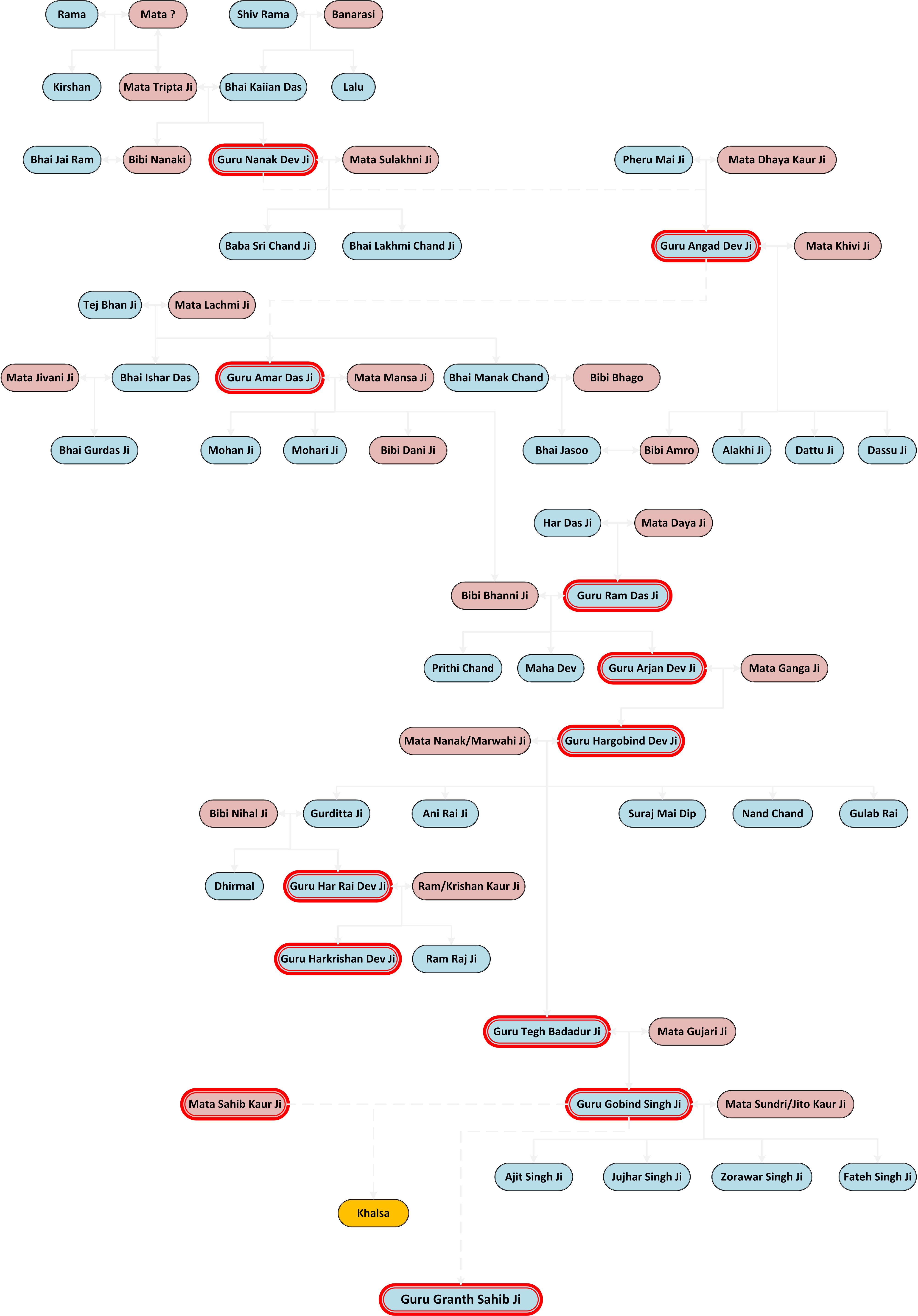The following is a family tree of the Sikh Gurus and shows the beginning of Sikhism from Guru Nanak right through to the present day, Guru Granth Sahib and Khalsa community
Parents and siblings of the Gurus are shown in the family tree. Males are shown as blue and female as pink boxes. You will see some boxes with incompleted names with a "?". If you know these please help by sending us your request and we will consider to add and complete this family tree
By clicking on each of the red outlined boxes below, you can read up on these divine mortals of God
|
|
|
|
|
|
Sikh Guru History |
Guru Nanak Dev Ji
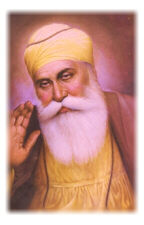 |
Lived from 1469 to 1539 [70yrs]
1st Guru and Founder of Sikh religion
Had Hindu and Muslim friends from childhood and an accountant by profession in his youth years
Mardana was a Muslim childhood friend who accompanied Guru Nanak Dev Ji everywhere most of his life
Guru Nanak Dev Ji institutionalized the common kitchen called Langar in Sikhism. Here all could sit together and share a common meal, whether they were kings, beggars, class, colour or creed
Guru Nanak Dev Ji uttered the following recital that is now our Japji (Song in prase of GOD)
There is but One God, His name is Truth
He is the Creator, He fears none, He is without hate
He never dies, He is beyond the cycle of births and death, He is self illuminated
He is realized by the kindness of the True Guru
He was True in the beginning
He was True when the ages commenced and has ever been True
He is also True now
Late in his life (1532) Guru Nanak Dev Ji was approached by a new devotee "Lehna" (a Hindu devotee to God Durga). Lehna fell in love with Guru Nanak Dev Ji's belief and morals and started to follow him everywhere. Later on Guru Nanak blessed Lehna with his ang (hand) and gave him a new name, Angad,saying "you are a part of my body" and so Sikhism continued with our second Guru ..... Guru Angad Dev Ji
Follow this link for further history on
Guru Nanak Dev Ji -1
or
Guru Nanak Dev Ji -2
Guru Angad Dev Ji
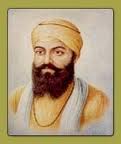 |
Lived from 1504 to 1552 [48yrs]
2nd Guru of Sikhism
Born on March 31st he met Guru Nanak at the age of 27 when his previous name was Lehna.
Guru Nanak appointed Guru Angad as his successor on July 14, 1539
Guru Angad did not believe in performing miracles unnecessarily
Origins of the Gurmukhi script are unclear however it is clear that Guru Angad popularized the use of this simplified script among the Sikhs starting around 1541
Amar Das was a devotee Hindu who eventually met Guru Angad Dev Ji.
Every year Guru Angad would present a turban as a symbol of honour to his devoted followers. Such was the devotion of Amar Das that he would wear one on top of the other, refusing to discard the Guru's gift. People ridiculed Amar Das for his blind faith, but he was never concerned.
Finding that Amar Das was his most worthy disciple and feeling that his end was near Guru Angad announced that Amar Das would be his successor. Guru Angad's two sons were unhappy with their fathers decision but the Guru told them that the honour would go to Amar Das because he was the most worthy and humble. Shortly thereafter Guru Angad left this world on March 28, 1552, so Sikhism continued with our third Guru ..... Guru Amar Das Dev Ji
Follow this this link for further history on
Guru Angad Dev Ji -1
or
Guru Angad Dev Ji -2
Guru Amar Das Dev Ji
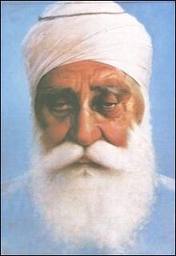 |
Lived from 1479 to 1574 [95yrs]
3rd Guru of Sikhism
Guru Amar Das was born in the village of Basarke as a Hindu devotee
Amar Das met Guru Angad and converted to the path of Sikhism and became a Guru at the age of 73 succeeding Guru Angad
The concept of Langar kitchen was carried on by Guru Angad Dev Ji and was open to serve all day and night. Guru Amar Das made it obligatory that those seeking his audience must first eat in the langer
Guru Amar Das not only preached the equality of people irrespective of their caste but he also tried to foster the idea of women's equality
Guru Amar Das also declared Baisakhi (April 13), Maghi (1st day of Magha, mid January) and Diwali (festival of lights in October/November) as three special days where all the Sikhs should gather to hear the Guru's words
He trained a band of 146 apostles (52 were women) called Masands and sent them to various parts of the country. He also set up 22 dioceses called Manjis across the country to preach and teach the ways of Sikhism
Guru Amar Das asked his son-in-law Jetha to oversee the founding of another city. He wanted him to dig a bathing tank there and to build himself a house. This new township called Ramdaspur where Jetha started digging on the tank. This town Ramdaspur would become present day Amritsar, the holiest city of the Sikhs
Nearing his end he called upon his two son and son-in-law Jetha. He declared;
According to the tradition established by Guru Nanak, the leadership of the Sikhs must go to the most deserving. I, therefore, bestow this honour on my son-in-law Jetha
Guru Amar Das then renamed Jetha as Ram Das, meaning Servant of God and thus the continuation of Sikhism continued with our fourth Guru ..... Guru Ram Das Dev Ji
Follow this this link for further history on
Guru Amar Das Dev Ji -1
or
Guru Amar Das Dev Ji -2
Guru Ram Das Dev Ji
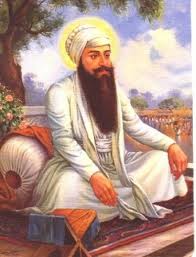 |
Lived from 1534 to 1581 [47yrs]
4th Guru of Sikhism
Born on September 24th, to simple God-fearing parents, Hari Das and Anup Devi of Lahore. Known as Jetha meaning the first born, he was a handsome young man
Jetha became a disciple of Guru Amar Das. His hard work, and devotion eventually won him the hand of Guru Amar Das's younger daughter, Bibi Bhani. Eventually Jetha was ordained as Guru Amar Das's successor and named Guru Ram Das, meaning servant of God
Guru Ram Das started the town RamDas and building bathing baths. Today the city which is the holiest center of Sikhism has come to be know as Amritsar
The standard Sikh marriage ceremony known as the Anand Karaj is centered around the Lawan, a four stanza hymn which was composed by Guru Ram Das Dev Ji. The marriage couple circle the Guru Granth Sahib as each stanza is read.
- The first round is the Divine consent for commencing the householders life through marriage
- The second round states that the union of the couple has been brought about by God
- In the third round the couple is described as the most fortunate as they have sung the praises of the Lord in the company of saints
- In the fourth round the feeling of the couple that they have obtained their hearts desire and are being congratulated is described
Arjan who was Guru Ram Das Dev Ji's youngest son and the favorite (Arjan) was send by his father to Lahore to preach to all the Sikhs there. Soon his father missed him and called him back and blessed him to follow as the next Guru. Shortly thereafter Guru Ram Das breathed his last on September 1st 1581.
Follow this this link for further history on
Guru Ram Das Dev Ji -1
or
Guru Ram Das Dev Ji -2
Guru Arjan Dev Ji
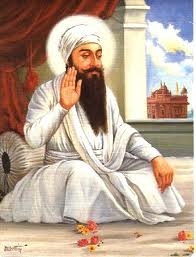 |
Lived from 1563 to 1606 [43yrs]
5th Guru of Sikhism
Guru Arjan left for Ramdaspur (Amritsar) to complete the work started by his father where he completed the two tanks of Santoksar and Amritsar and undertook the build of Harmandir Sahib - The Golden Temple
The Golden Temple was build by Guru Arjan and to counter the Muslim belief that God's House is in the west and the Hindu belief that it is in the east where the sun rises, the Harmandir Sahib had entrances on all four sides. Guru Arjan exclaimed:
My faith is for the people of all castes and all creeds from whichever direction they come and to whichever direction they bow
Guru Arjan Dev Ji having given the Sikhs a central place of worship (The Golden Temple) decided to squash his eldest brother jealously and trying to pass his own hymns as Guru's hymns, decided all Sikhs now needed an authentic compilation of the hymns of their Guru's and started the arduous task of compiling the first edition of the Holy Guru Granth Sahib
The first edition of the Guru Granth Sahib was known at that time as Pothi Sahib and was installed on a high pedestal within the Harmandir Sahib in August 1604. All Sikhs were asked to bow before it, not as an idol, but as the book of divine inspiration which instructed living men in the ways of God. The revered Baba Buddha was appointed the first Granthi (custodian) of the book. Guru Arjan dictated that unlike the Hindu scriptures, the Pothi Sahib could be open to reading by anyone of any caste, creed or sex. This original copy is still in existence today
After Emperor Akbar's death his son Jahangir succeeded him and did not take a liking to Sikhism or Guru Arjan Dev Ji. He ordered that the Guru be brought into his presence and demanded that Guru Arjan revise the Holy Granth, removing all references to Islam and Hinduism. This of course the Guru refused to do. For this he was was cruelly tortured. He was made to sit on a red hot iron sheet. They poured burning hot sand on his body. The Guru was dipped in boiling water! Guru Arjan Dev Ji still did not bow to any of the demands.
On May 30, 1606 the Guru asked for a bath in the river Ravi by the side of the Mughal fort (his prison). Thousands of followers watched the Guru who could barely walk make his way to the river with tears in their eyes. His bare body was covered with blisters, Guru Arjan repeated over and over;
Sweet is Your will, O God; the gift of your Name alone I seek
The Guru then calmly walked into the river bank, bidding his farewell to his followers and was gone forever, his body carried away by the currents....
Hargobind who was the only son of Guru Arjan Dev Ji was anointed as Sikhs 6th Guru
Follow this this link for further history on
Guru Arjan Dev Ji -1
or
Guru Arjan Dev Ji -2
Guru Hargobind Dev Ji
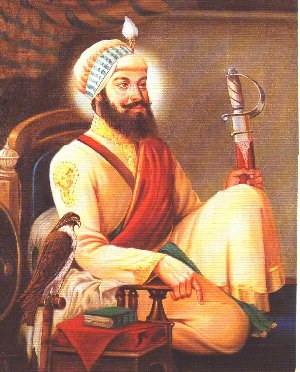 |
Lived from 1595 to 1644 [49yrs]
6th Guru of Sikhism
The only child of Guru Arjan Dev was appointed with the Guruship on May 25, 1606 just days before his fathers martyrdom and from a young age he was educated in the sciences, sports and religion as his father had insisted
The Guru would always carry two swords to symbolize his dual role of holding secular power (Miri) and spiritual authority (Piri)
Guru Hargobind laid the foundation of a new temple at Amritsar; the Akal Takht. The Akal Takht was built facing Harmandir Sahib (the Golden Temple). Guru Hargobind had a throne built, and would administer Sikh affairs from here
Guru Hargobind donned the royal regalia of a King and was known by the Sikhs as Sacha Padshah (The True King).
When confronted by Emperor Jehangir, who then asked Guru "Which religion is better Hinduism or Islam?", this was the Guru Hargobind Dev Ji's reply...
God first created light. All men are born out of it. The whole world came out of a single spark;
Who is good and who is bad?
The Creator is in the creation, and the creation in the Creator, He is everywhere
The clay is the same, the potter fashions various models.
There is nothing wrong with the clay or the potter
God the true resides in all, Whatever happens is His doing
He who surrenders to Him gets to know Him. He is His slave
Once the Emperor found out that Guru Hargobind enjoyed hunting he was invited to accompany the Emperor on numerous trips. During one of these chases the Emperor was attacked by a ferocious tiger. The attendants accompanying the royal party lost their nerve and their horses and elephants panicked. Guru Hargobind rushed his horse and pulling out his sword, he engaged the killed the dangerous tiger single handed. Emperor Jehangir became very fond of the Guru.
However years later the mughal emperor Jahangir's favorite hunting hawk flew into the camp of Guru Hargobind who was also hunting. When the emperors soldiers came to reclaim the hawk, a brief skirmish ensued and the hawk was not returned. Jahangir was so enraged that he sent an army of 7000 cavalry to recover both the hawk and capture the Guru for his insolence. In the ensuing battle the Gurus forces emerged victorious. This battle took place in 1634. This battle marked a turning point as the Sikhs now turned militant under mughal persecution
Guru Hargobind Dev Ji borne 5 sons, however none were could fill the next successor to been a seventh Guru, so Guru Hargobind started training his grandson Har Rai who was son of Baba Gurditta, as his natural successor. Baba Gurditta was eldest son of Guru Hargobind, but died quite early on at the young age of 24. Har Rai was a pious young man and Guru Hargobind proceeded to train him in the use of arms as well as spiritual matters. At the age of fourteen Har Rai was ordained by Guru Hargobind as the seventh Sikh Guru. Guru Hargobind bowed before Guru Har Rai as his successor. Soon thereafter Guru Hargobind passed away in 1644 having in his lifetime transforming the Sikhs into soldier-saints
Follow this this link for further history on
Guru Hargobind Dev Ji -1
or
Guru Hargobind Dev Ji -2
Guru Har Rai Dev Ji
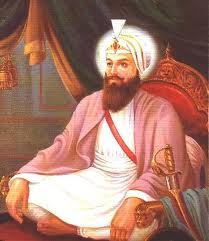 |
Lived from 1630 to 1661 [31yrs]
7th Guru of Sikhism
Born on January 16, 1630 in Kiratpur to Baba Gurditta the eldest son of Guru Hargobind. From a very young age he exhibited a sensitivity to all living things and endeared himself to his grandfather Guru Hargobind
The Guru continued to spread the message of Sikhism. He sent Bhagwan Gir to eastern India to preach Sikhism. Another disciple Bhai Pheru was sent to Rajasthan and Suthre Shah was appointed to Delhi
Once Guru Har Rai came upon a large snake basking in the sunlight and he exclaimed
This serpent might as well have been a pundit in his previous life; beautiful to behold in his dress, but the knowledge he has is to bite.
Men also bite others through jealousy; even when they teach about God it is not through love or self-surrender, but through the sharp wits and poisonous fangs of controversy and argument
When Aurangzeb took over from Shah Jehan's reign (after killing his brothers to do so) he turned his attention towards Sikhism and remembering that Guru Har Rai Dev Ji had once helped his older brother, Dara Shikoh who was executed eventually by the new emperor Aurangzeb.
Henceforth trouble started between the Guru Har Rai and the emperor who decided to send his younger son Ram Rai to represent him before the royal court. However Ram Rai decided to sacrifice the teaching of the Sikhs and teachings by changing some of Guru Nanak's verses to suit what the emperor would be pleased to hear. When it was reported back to Guru Har Rai what his son had done, he was deeply hurt and decided not to ever see his son's face ever again.
Since Ram Rai had proved a disappointment to his father, Guru Har Rai appointed his younger son Harkrishan as the next Guru and passed away soon thereafter on October 6, 1661
Follow this this link for further history on
Guru Har Rai Dev Ji -1 or
Guru Har Rai Dev Ji -2
Guru Harkrishan Dev Ji
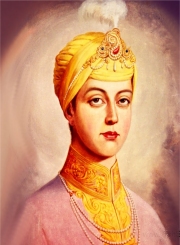 |
Lived from 1656 to 1664 [8yrs]
8th Guru of Sikhism
Guru Harkrishan was born on July 7, 1656 to Guru Har Rai and Krishan Kaur and he was only 5 years old when he received his Guruship
In the family there were two sons and a lot of friction existed between the two
The eldest son i.e. Ram Rai was disowned by his father i.e. Guru Har Rai some time ago. This was because when Guru Har Rai sent his eldest son Ram Rai to meet up with then Mughal emperor Aurengzeb (a cruel ruler). During this visit Ram Rai offended his father by changing the Holy Scriptures uttered by Guru Nanak, just so as to please the Mughal emperor and look good in his eyes
So before Guru Har Rai passed away he choose his youngest son, Guru Harkrishan Dev Ji as the successor over his elder son, Ram Rai and this led to a division in the family
Ram Rai who now was in good stead with the Moghul emperor complained to the emperor, due sheer jealousy on how he was cut off the inheritance of his father and also from the successor of Guruship that his younger brother received from the farther
Due to this the emperor Aurengzeb ordered the young Guru Harkrishan Dev Ji to come to Delhi capital and appear in his court. After some reluctance by all the Sikhs, fearing for the life of the young Guru, he set out to meet emperor with Raja Jai Singh, who promised to protect the young Guru
On reaching Delhi a large number of Sikh devotees were gathering to see the young Guru and get his blessing, unfortunately at this time a smallpox epidemic was starting to rage through Delhi capital. In spite of this the young Guru continued to see his devotees and give his blessings and with this physical contact the Guru was also infected and taken seriously ill and unfortunately passed away at a tender age of eight years old
Follow this link for further history on
Guru Harkrishan Dev Ji -1 or
Guru Harkrishan Dev Ji -2
Guru Tegh Bahadur Ji
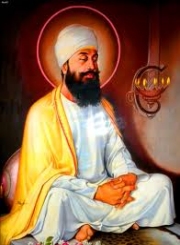 |
Lived from 1621 to 1675 [54yrs]
9th Guru of Sikhism
Guru Tegh Bahadur was the youngest son of Guru Hargobind and Bibi Nanki and was born at Amritsar on April 1, 1621. From young age he was trained as a swordsmanship and horse riding and in his younger years fought alongside this farther side (Guru Hargobind Dev Ji)
However after one such battle he decided to turn to the path of renunciation and mediation and settled in Bakala and became to be know as Tyag Mal meaning “The Master of Renunciation”
Guru Hargobind Dev Ji did not choose his son Guru Tegh Bahadur as his successor as he felt that his son was not a leader to lead as he had taken the path of mediation and renunciation. After the untimely death of young Guru Harkrishan death a lot of confusion arose as to then next successor and a lot of people started claiming rights and belonging to the late Guru Harkrishan family tree
Meanwhile a wealthy merchant Makhan Shah, while travelling with his important cargo ships got caught up in a fierce storm at sea. He vowed to then offer 500 gold coins to the heavens for safety reaching home. His wish was fulfilled and his merchandise safety arrived at the port. On hearing the young Guru Harkrishan’s death he decided to go to Bakala and see all these new claimants to the succession of next Sikh’s Guru. Mankan Shah decided to pay homage to the so called claimants by visiting them and offering 2 gold coins as a tribute to each. This he did to each on reaching Bakala, but he still was not convinced that either one of them was true Guru and decided to leave.
However before he could he heard that there was another holy man in town and decided to visit him. This was Guru Tegh Bahadur who usually deep in his meditation did not like receiving visitors, however Makan Shah still decided to wait and eventually on seeing the Guru, gracefully placed 2 gold coins as a tribute in front of the Guru Tegh Bahadur. Seeing this the Guru looked and smiled at Makan Shah and said:
I thought that you had pledged 500 gold coins
Hearing this without any prompt, Makan Shah was completely stunned and became so elated that he kissed the Gurus feet and started shouting from the rooftop
I've found the Guru, I found the True Guru!
The Guru travelled throughout Punjab, spreading the Sikhism belief and wherever he would stop the Guru would get wells dug for the people and community kitchens set up. Wherever the Guru stopped he would preach about honest work and charity. The Guru would also give away all the offerings that he would receive from devotees.
At Priyag, the Gurus wife Mata Gujri conceived a child and in December of 1666 while on Guru Tegh Bahadur was on his eastern tour he received the news that he had been blessed with a child, a son named Gobind Rai. On his return Guru Tegh Bahadur spent over a year with his family training his son in the Sikh Scriptures, horse riding and swordsmanship
Emperor Aurangzeb was then the Mughal emperor in power, but was a tyrant ruler who wish to crush all religions but Islam and convert everyone in India to Muslims. Guru Tegh Bahadur stood up to protect all Hindus under this threat regardless of what is outcome would be. This was his sign of bravery for humanity and oppression. He was arrested by Aurangzeb troops and was subjected to many cruelties, he was kept in an iron cage and starved for many days. His three companions, Bhai Mati Das, Bhai Sati Das and Bhai Dyala were also imprisoned along with the Guru.
The Guru was made to watch as Bhai Mati Das was tied between two pillars and his body split in two by being sawn alive. Bhai Dyala was boiled alive in a cauldron of boiling water and Bhai Sati Das was wrapped in cotton wool and set on fire. The Guru bore these cruelties without flinching or showing any anger or distress. Finally on November 11, 1675 Guru Tegh Bahadur was publicly beheaded with the sword of the executioner as he prayed.
A Sikh named Bhai Jaita managed to collect the Guru's sacred head and carried it off to Anandpur Sahib to the Guru's son. Another Sikh Bhai Lakhi Shah who had a cart was able to smuggle the Gurus headless body to his house. Since a public funeral would be too dangerous, Bhai Lakhi Shah cremated the body by setting his house on fire. Meanwhile the head was taken to the grief stricken young Guru Gobind Singh and the widow Mata Gujari. On November 16, 1675 at Anandpur Sahib, a pyre of sandalwood was constructed, sprinkled with roses and the head of Guru Tegh Bahadur was cremated by young Guru Gobind Singh
Thus ended the earthly reign of the ninth Nanak, Guru Tegh Bahadur. Never through all history has a religious leader of one religion sacrificed his life to save the freedom of another religion
Hence forward began our Tenth and final mortal Guru to take Sikhism to glorious heights and one that we all find so incredible to bear and see the sacrifices by these divine mortals, made in the name of our LORD.
Follow this link for further history on
Guru Tegh Bahadur Dev Ji -1 or
Guru Tegh Bahadur Dev Ji -2
Guru Gobind Singh Ji
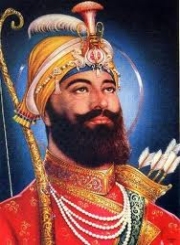 |
Lived from 1666 to 1708 [42yrs]
10th Guru of Sikhism
Born in Patna, Bihar in India, he was also a warrior, poet and philosopher. He succeeded his father Guru Tegh Bahadur as the leader of Sikhs at a young age of nine
He learned Persian and Sanskrit when he was a child and was also trained to become a warrior
Guru Gobind Singh transformed Sikhs into Khalsa (pure) in 1699. Guru Gobind Singh Ji was a brave warrior and fought many victorious battles throughout his life
In 1699, the Guru sent Hukamnamas (letters of authority) to his followers, requesting them to congregate at Anandpur, the day of Vaisakhi (the annual harvest festival). He addressed the congregation from the entryway of a small tent pitched on a small hill. He first asked everyone who he was for them. Everyone answered
You are our Guru
He then asked them who were they, to which everyone replied
We are your Sikhs
Having reminded them of this relationship, he then said that today the Guru needs something from his Sikhs and everyone said
Hukum Karo, Sache Patshah (Order us, True Lord)
Then drawing his sword he asked for a volunteer who was willing to sacrifice his head. No one answered his first call, nor the second call, but on the third invitation, Daya Ram came forward and offered his head to the Guru. Guru Gobind Rai Ji took the volunteer inside the tent. The Guru returned to the crowd with blood dripping from his sword. He then demanded another head. One more volunteer came forward, and entered the tent with him. The Guru again emerged with blood on his sword. This happened three more times. Finally all of the five volunteers merged from the tent in new clothing completely unharmed
Guru Gobind Rai Ji then poured clear water into an iron bowl and adding Patashas (Punjabi sweeteners) into it, he stirred it with double-edged sword accompanied with recitations from Adi Granth. He called this mixture of sweetened water and iron as Amrit ("nectar") and administered it to the five men
These five, who willingly volunteered to sacrifice their lives for their Guru, were given the title of the Panj Piare ("the five beloved ones") by their Guru. They were the first Sikhs of the Khalsa:
Daya Ram (Bhai Daya Singh); Dharam Das (Bhai Dharam Singh); Himmat Rai (Bhai Himmat Singh); Mohkam Chand (Bhai Mohkam Singh); Sahib Chand (Bhai Sahib Singh)
Guru Gobind Rai Ji then recited a line which has been the rallying-cry of the Khalsa since then
Waheguru Ji Ka Khalsa, Waheguru Ji Ki Fateh
Khalsa belongs to God, Victory belongs to God
He gave all name "Singh" (lion) and designated them collectively as Khalsa (the Pure Ones), the body of baptized Sikhs. The Guru then astounded the five and the whole assembly as he knelt and asked them to in turn initiate him as a member, on an equal footing with them in the Khalsa, thus becoming the sixth member of the new order. His name became
Guru Gobind Singh Ji
Women were also initiated into the Khalsa and given the title of Kaur ("princess"). Today members of the Khalsa consider Guru Gobind as their father and Mata Sahib Kaur as their mother
During Emperor Aurangzeb reign his governor Wazir Khan who was desperate in trying to catch Guru Gobind Singh Ji managed to ambush the Guru's mother i.e. Mata Gujri and the Guru’s two younger sons Zorawar Singh and Fateh Singh who were betrayed by the cook Gangu who the Guru had entrusted to look after his family
The two sons of Guru Gobind, Zorawar (9 years old) and Fateh (7 years old) were offered safe passage if they became Muslims . Both refused, and the cruel Wazir Khan sentenced them to death by bricking the two young boys alive with a brick wall! Mata Gujri died soon after hearing of her grandsons' death
Guru Gobind Singh Ji was devastated with what happened to his young sons. Later on the Guru decided to wage battle against the emperor and Wazir Khan, then the Nawab of Sirhind, felt uneasy about any conciliation between Guru Gobind Singh. He hired two Pathans to assassinate the Guru and they secretly pursued the Guru and got an opportunity to attack him at Nanded
The Guru was stabbed in the left side below the heart while he was resting in his chamber after the Rehras prayer. Guru Gobind Singh killed the attacker with his Talwar (traditional Sikh curved sword), while the attacker's companion tried to flee but was killed by Sikhs who had rushed in on hearing the noise. The wound was stitched but it re-opened as the Guru practised with this bow and started bleeding profusely. Sensing that his earthly time was coming to an end he sang his self-composed hymn:
Aya bhai Akal ki tabhi chalayo Panth Sabh
Sikhan ko hukam hai Guru Maneyo Granth,
Guru Granth Ji manyo pargat Guran ki deh
Jo Prabhu ko milbo chahe khoj shabad mein le
Raj karega Khalsa aqi rahei na koe Khwar hoe sabh milange bache sharan jo hoe
Translated:
Under orders of the Immortal Being, the Panth was created.
All the Sikhs are enjoined to accept the Granth as their Guru.
Consider the Guru Granth as embodiment of the Gurus.
Those who want to meet God, can find Him in its hymns
The Khalsa shall rule, and impure will be no more, Those separated will unite and all the devotees shall be saved
The Guru left the earthly body, along with his horse Dilbagh (also known as Neela Ghora) on 7 October 1708 at Nanded and with his last beautiful hymn he declared the Guru Granth Sahib as his successor
Follow this link for further history on
Guru Gobind Singh Ji
Mata Sahib Kaur Ji
 |
Lived from 1681 to 1747 [66yrs]
Mata Sahib Kaur also known as Mata Sahib Devan was adorned as spiritual Mother of the Khalsa
She earned the distinction by instilling the first Amrit with the sweetness by adding Pataasey (sugar wafers) to the Amrit, and was bestowed the honour of eternal motherhood of Khalsa Panth
Mata Sahib Devan’s was a quite natured girl and brought up in a religious atmosphere and also deeply influenced by Gurbani. Her father was a devotee to Guru Gobind Singh Ji and as a consequence she was influenced by Guru Ji’s aura
Mata Sahib Kaur Ji's father had pledged his daughter to Guru Sahib and no-one else could marry her. Mata Sahib Ji's father requested Guru Gobind Singh Ji to take his daughter as his bride. However Guru Ji told the gathering that he was already married.
Seeing the devotion Guru Gobind Singh agreed that Mata Sahib Kaur Ji could stay with the Guru's family, however, they could not marry, have any physical relationship or ever have children. Mata Sahib Kaur Ji lived in the Guru's household and served Guru Ji and the Sangat with full shardaa (devotion). Guru Sahib promised Mata Sahib Kaur Ji that she will become a great Mother to thousands and this was achieved at the ceremony of serving the Amrit and the start of Khalsa (pure)
Mata Sahib Kaur Ji, passed away before Mata Sundri Ji (Guru Ji’s wife). She left for heavenly abode at the age of sixty six in 1747 and her last rites were performed in Bala Sahib, Delhi
Follow this link for further history on Mata Sahib Kaur Jj
Guru Granth Sahib Ji
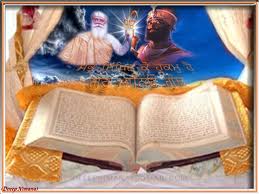 |
From 1708 - Present (and future)
Guru Granth Sahib (originally known as Adi Granth) was originally first compiled by the fifth Sikh guru, Guru Arjan Dev from all the collection of all the predecessors Guru Prayers and hymns, starting from Guru Nanak Dev Ji. Later all the Gurus after Arjan Dev Ji had some hand in the re-compilation of the Holy book
The Guru Granth Sahib Ji is collections of text of 1430 pages or Angs (limbs), complied and composed during the period of Sikh Gurus from 1469 to 1708
It is a collection of hymns (Shabad) or Baani describing the qualities of God and why one should meditate on God's name. The Granth Sahib is written manly in Gurmukhi. Gurmukhi translated -Word of Guru or sometime also called Guru Ki Bani – Word of God
It can be divided into three different sections:
Introductory section consisting of the Mul Mantra, Japji and Sohila composed by Guru Nanak
Compositions of Sikh Gurus followed by those of Different Bhagats who just know Only the God, collected according to chronology of Ragas or musical notes (see below)
Compositions of Guru Tegh Bahadur
Guru Granth Sahib was appointed as the Eleventh Guru by the Tenth Guru, Guru Gobind Singh Ji. It is the ultimate teacher of the Sikhs
According to Guru Gobind Singh Ji’s poet follower, shortly before Guru Ji’s worldly departure the Sikhs enquired as to whom he was entrusting his Khalsa… To this the Guru replied that he will have three forms! The first was nirgun or invisible, the second was his word and the third was sagun or the visible. All of this became clearer after Guru Ji’s departure to the heavenly abode
The first nirgun or invisible was been referred to as Guru Ji’s invisible soul after physical death
His second form would be Adi Granth (present Granth Sahib), as Guru Gobind Singh Ji’s last words were
Dusar Rup Granthji jan (The Granth is second myself)
Mera rup Granthji jan (Consider the Granth as my own self)
Is men bhed nahin kuchh man (Have not the least doubt about it)
The third sagun, or visible rup was the Khalsa followers that were started and blessed by the Guru
The original Guru Granth Sahib was lost in the Sikh holocaust of 1762. The edition used in Sikh Gurdwaras today is based on the copies produced at Damdama Sahib by Bhai Mani Singh. This final compilation of the Guru Granth Sahib had many copies made and circulated. Any printer's waste which has any of its text on, are cremated with a similar ceremony as cremating a deceased person. Such burning is called Agan Bhet.
The Sri Guru Granth Sahib Ji is currently printed in an authorized printing press in the basement of the Gurdwara Ramsar in Amritsar, with the waste printing being cremated at Goindval Gurdwara
Follow this link for further history on Guru Granth Sahib Ji

